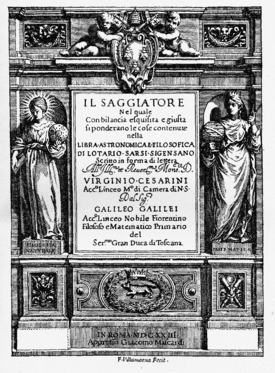This is an old revision of this page, as edited by William M. Connolley (talk | contribs) at 21:23, 23 June 2015 (as before). The present address (URL) is a permanent link to this revision, which may differ significantly from the current revision.
Revision as of 21:23, 23 June 2015 by William M. Connolley (talk | contribs) (as before)(diff) ← Previous revision | Latest revision (diff) | Newer revision → (diff)

The Assayer (Template:Lang-it) was a book published in Rome by Galileo Galilei in October 1623 and is generally considered to be one of the pioneering works of the scientific method, first broaching the idea that the book of nature is to be read with mathematical tools rather than those of scholastic philosophy, as generally held at the time.
Grassi on the comets
The immediate context of the book was a polemic against the treatise on the comets of 1618 by Orazio Grassi, a Jesuit mathematician at the Collegio Romano. In this matter Grassi, for all his Aristotelianism, was right and Galileo was wrong. Galileo incorrectly treated the comets as a play of light rather than as real objects. At the time comets as celestial bodies were thought to be a threat to the Copernican system since they did not appear to move in periodic orbits.
Mathematics and philosophy in The Assayer
In 1616 Galileo may have been silenced on Copernicanism. In 1623 his supporter and friend, Cardinal Maffeo Barberini, a former patron of the Lynx and uncle of future Cardinal Francesco Barberini, became Pope Urban VIII. The election of Barberini seemed to assure Galileo of support at the highest level in the Church. A visit to Rome confirmed this.
The title page of The Assayer shows the crest of the Barberini family, featuring three busy bees. In The Assayer, Galileo weighs the astronomical views of a Jesuit, Orazio Grassi, and finds them wanting. The book was dedicated to the new pope. The title page also shows that Urban VIII employed a member of the Lynx, Cesarini, at a high level in the papal service. This book was edited and published by members of the Lynx.
Again Galileo insisted that physics should be mathematical. According to the title page, he was the philosopher or physicist of the Grand Duke of Tuscany, not merely the mathematician. Physics or natural philosophy spans the gamut from processes of generation and growth (represented by a plant) to the physical structure of the universe, represented by the cosmic cross-section. Mathematics, on the other hand, is symbolized by telescopes, and an astrolabe. This is the book containing Galileo’s famous statement that mathematics is the language of science. Only through mathematics can one achieve lasting truth in physics. Those who neglect mathematics wander endlessly in a dark labyrinth. From the book:
Philosophy is written in this grand book — I mean the universe — which stands continually open to our gaze, but it cannot be understood unless one first learns to comprehend the language and interpret the characters in which it is written. It is written in the language of mathematics, and its characters are triangles, circles, and other geometrical figures, without which it is humanly impossible to understand a single word of it; without these, one is wandering around in a dark labyrinth.
Although The Assayer contains a magnificent polemic for mathematical physics, ironically its main point was to ridicule a mathematical astronomer. This time, the target of Galileo’s wit and sarcasm was the cometary theory of a Jesuit, Orazio Grassi, who argued from apparent absence of observable parallax that comets move beyond the Moon. Galileo mistakenly countered that comets are an optical illusion.
Galileo’s polemical tone was common at the time. However, the book was read with delight at the dinner table by Urban VIII. In 1620 Maffeo Barberini wrote a poem entitled Adulatio Perniciosa in Galileo's honor.
See also
References
- Pietro Redondi, Galileo: heretic, Princeton University Press, 1987, page 31.
- Galileo Galilei, The Assayer, as translated by Stillman Drake (1957), Discoveries and Opinions of Galileo pp. 237-8.
- Amir Alexander (2014). Infinitesimal: How a Dangerous Mathematical Theory Shaped the Modern World. Scientific American / Farrar, Straus and Giroux. ISBN 978-0374176815., p. 131
- http://galileo.rice.edu/chron/galileo.html
Sources
- Galileo Galilei, Il Saggiatore (in Italian) (Rome, 1623); The Assayer, English trans. Stillman Drake and C. D. O'Malley, in The Controversy on the Comets of 1618 (University of Pennsylvania Press, 1960).
- Pietro Redondi, Galileo eretico, 1983; Galileo: Heretic (transl: Raymond Rosenthal) Princeton University Press 1987 (reprint 1989 ISBN 0-691-02426-X); Penguin 1988 (reprint 1990 ISBN 0-14-012541-8)
| Galileo Galilei | |
|---|---|
| Scientific career | |
| Works |
|
| Family |
|
| Related | |
| In popular culture | |